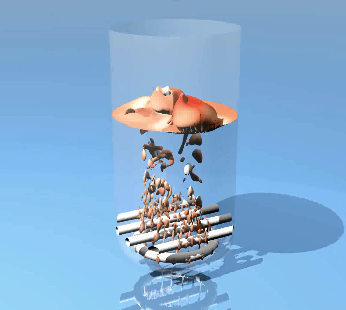There are approximately one million gallons of radioactive sodium-bearing liquid waste being stored at the Idaho Nuclear Technology and Engineering Center at the Idaho National Laboratory (INL) site. To reduce the environmental footprint, the Department of Energy has made it a priority to treat and dispose of the waste in long-term storage facilities. The Idaho Cleanup Project has selected the THOR® fluidized bed steam reforming technology to treat and reduce the waste to granular product that is suitable for long-term storage at the Waste Isolation Pilot Plant (WIPP) in New Mexico. This technology has been demonstrated for a pilot-scale unit and performance of the scaled up unit is being evaluated.
The National Energy Technology Laboratory (NETL) is helping the Idaho Cleanup Project by leveraging its expertise in multiphase flow science and high performance computing and using the NETL MFiX Suite of multiphase flow software to model the complex hydrodynamic and chemical behavior in the system. This work will accelerate the development of the treatment unit by identifying strategies to optimize performance, interpreting experimental data, and testing potential design and operation improvements before incurring costly design changes or operations testing.
Sodium bearing waste is a radioactive aqueous solution that contains nitric acid, nitrates, alkali metals, aluminum, and a wide variety of inorganic oxides. The THOR® steam reforming process converts the liquid waste to a granular product, where hazardous materials are thus immobilized. These processes are performed in two fluidized bed reformers, the Denitration and Mineralization Reformer (DMR) and Carbon Reduction Reformer (CRR). The vessels are modeled using the MFiX Suite, an open-source modeling toolset developed at NETL for solving reactive multiphase flows (https://mfix.netl.doe.gov/).
The simulations include complex vessel geometries, such as internal cyclones in the DMR, fluidizing gas ring and rail headers, waste feed nozzles, thermal control nozzles, and coal (DMR) or coke (CRR) inlet pipes. The liquid waste, bed material, coal or coke additives, and gas phases are all modeled as interpenetrating continua that are coupled via interphase exchange terms and heterogeneous chemical reactions. The simulations include reaction sets for coal and coke chemistry as well as reactions for processing waste. The chemical reactions are integrated into MFiX through C3M, a chemistry management software developed at NETL.
The simulations are computationally intensive and are made feasible by NETL’s high performance computing facility – the Joule Supercomputer (https://hpc.netl.doe.gov/). Each vessel is simulated using approximately 448 processors, and each simulation requires approximately 150,000 core hours to reach a statistically steady state.
Simulations of the CRR have been used to understand the chemical and hydrodynamic behavior inside of the vessel and provide data to assist the IWTU project. The CRR simulations predict an outlet gas composition that closely agrees with the design predictions, giving confidence in the model accuracy. Our simulations are also being used to study the effects of attrition in the CRR. Attrition can cause fine particles to form which can then be elutriated from the vessel.
To reduce particle attrition and elutriation, a parametric study of different control nozzle configurations was performed. We have also completed simulations of the DMR, and are using the data to better understand vessel performance and the interactions between chemical and hydrodynamic behavior. The current set of simulations shows how the DMR performance changes as the simulant waste feed rates and nozzle atomizing gas ratios vary. The simulations show that the waste feed nozzles affect the hydrodynamics behavior of the DMR. The simulations will provide data that can help engineers select optimal operating conditions for the waste feed nozzles.
The simulations are being used to better understand how well the waste and bed material mix, and how mixing in the vessel affects the performance. Such simulation data complement available test data, and can be used to better understand the complex processes that occur in the IWTU.

Fig. 1. DMR geometry in the MFiX Model

Fig. 2. Examples of predicted DMR velocity contours from select cases

Fig. 3. Example of predicted gas species concentration in the CRR


